Correct Answer

verified
Correct Answer
verified
True/False
The long-run Phillips Curve is vertical at the natural rate of unemployment.
Correct Answer

verified
Correct Answer
verified
Multiple Choice
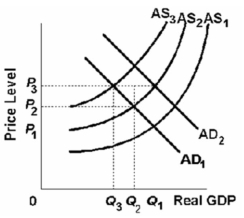 -Refer to the above graph.Assume that the economy is at equilibrium at AD1 and AS1 and then is hit with both demand-pull and cost-push inflation.If this occurs,then,in the short run:
-Refer to the above graph.Assume that the economy is at equilibrium at AD1 and AS1 and then is hit with both demand-pull and cost-push inflation.If this occurs,then,in the short run:
A) AD1 will shift to AD2,AS2 will shift to AS3,the price level will be at P2,and output will be at Q2.
B) AS1 will shift to AS3,AD2 will shift to AD1,the price level will be at P3,and output will be at Q3.
C) AD1 will shift to AD2,AS1 will shift to AS2,the price level will be at P2,and output will be at Q2.
D) AD1 will shift to AD2,AS1 will shift to AS2,the price level will be at P3,and output will be at Q1.
Correct Answer

verified
Correct Answer
verified
Multiple Choice
The Phillips Curve is based on the idea that with a constant short-run aggregate supply curve,a greater increase in aggregate demand is associated with a:
A) smaller increase in price level.
B) smaller increase in nominal wage rates.
C) greater increase in the unemployment rate.
D) greater increase in the rate of inflation.
Correct Answer

verified
Correct Answer
verified
Multiple Choice
A criticism of cuts in marginal tax rates is that they fail to:
A) decrease disinflation in the economy.
B) decrease demand-pull inflation in the economy.
C) increase aggregate supply more rapidly than aggregate demand.
D) increase aggregate demand more rapidly than aggregate supply.
Correct Answer

verified
Correct Answer
verified
Multiple Choice
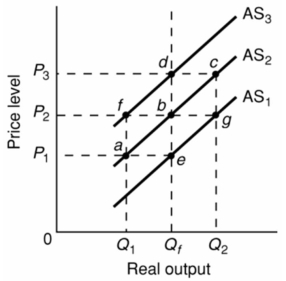 -The equilibrium price level and level of real output occur where:
-The equilibrium price level and level of real output occur where:
A) real output is at its highest possible level.
B) exports equal imports.
C) price is at its lowest level.
D) the aggregate demand and supply curves intersect.
Correct Answer

verified
Correct Answer
verified
Multiple Choice
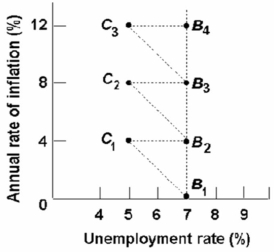 -Refer to the above graph.The full-employment unemployment rate in this economy would be:
-Refer to the above graph.The full-employment unemployment rate in this economy would be:
A) 5 percent.
B) 6 percent.
C) 7 percent.
D) 5-6 percent.
Correct Answer

verified
Correct Answer
verified
Multiple Choice
 -Refer to the above graph.Assume the economy is at the initial position of B1.An increase in aggregate demand will tend to:
-Refer to the above graph.Assume the economy is at the initial position of B1.An increase in aggregate demand will tend to:
A) temporarily shift the economy to point B2.
B) temporarily shift the economy to point C1.
C) permanently shift the economy to point C1.
D) have no effect in shifting the economy from point B1.
Correct Answer

verified
Correct Answer
verified
Multiple Choice
Many economists doubt the proposition that supply-side tax cuts increase aggregate:
A) demand more rapidly than aggregate supply.
B) demand less rapidly than aggregate supply.
C) supply more rapidly than aggregate demand.
D) supply less rapidly than aggregate demand.
Correct Answer

verified
Correct Answer
verified
Multiple Choice
A criticism of the arguments for tax cuts made by supply-side economists is that the:
A) demand-side effects will be stronger than the supply-side effects.
B) supply-side effects will be stronger than the demand-side effects.
C) supply-side effects will increase saving and reduce consumption.
D) demand-side effects will reinforce the supply-side effects,thus creating cost-push inflation.
Correct Answer

verified
Correct Answer
verified
Multiple Choice
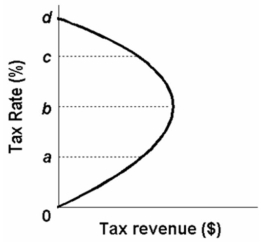 -The above curve is known as the:
-The above curve is known as the:
A) tax "wedge" curve.
B) Okun Curve.
C) Laffer Curve.
D) Phillips Curve.
Correct Answer

verified
Correct Answer
verified
Multiple Choice
 -Refer to the above diagram and assume the economy is initially at point b1.Which of the following movements is consistent with The Phillips Curve?
-Refer to the above diagram and assume the economy is initially at point b1.Which of the following movements is consistent with The Phillips Curve?
A) the movement from B1 to B2
B) the movement from B1 to C1
C) the movement from C1 to B2
D) the movement from B2 to B1
Correct Answer

verified
Correct Answer
verified
Multiple Choice
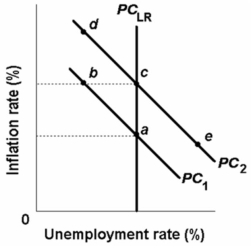 -Refer to the above diagram.Point b on short-run Phillips Curve PC1 represents a rate of:
-Refer to the above diagram.Point b on short-run Phillips Curve PC1 represents a rate of:
A) inflation below the natural rate.
B) inflation above the natural rate.
C) unemployment above the natural rate.
D) unemployment below the natural rate.
Correct Answer

verified
Correct Answer
verified
Multiple Choice
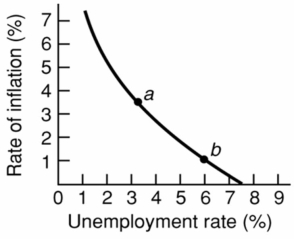 -Refer to the above diagram for a specific economy.The shape of this curve suggests that:
-Refer to the above diagram for a specific economy.The shape of this curve suggests that:
A) the price level rises at a diminishing rate as the level of aggregate demand increases.
B) full employment and price stability are compatible goals only when aggregate demand is falling.
C) each successive unit of decline in the unemployment rate is accompanied by a smaller increase in the rate of inflation.
D) each successive unit of decline in the unemployment rate is accompanied by a larger increase in the rate of inflation.
Correct Answer

verified
Correct Answer
verified
Multiple Choice
 -Refer to the above diagram.The move of the economy from c to e on short-run Phillips Curve PC2 would be explained by an:
-Refer to the above diagram.The move of the economy from c to e on short-run Phillips Curve PC2 would be explained by an:
A) increase in aggregate demand in the economy.
B) increase in aggregate supply in the economy.
C) actual rate of inflation that is less than the expected rate.
D) actual rate of inflation that exceeds the expected rate.
Correct Answer

verified
Correct Answer
verified
Multiple Choice
An increase in inflation is likely to occur when government:
A) counters cost-push inflation with a stimulative fiscal policy or monetary policy.
B) adopts a hands-off approach to cost-push inflation.
C) increases aggregate supply by lowering nominal wages.
D) increases aggregate demand by raising nominal wages.
Correct Answer

verified
Correct Answer
verified
Multiple Choice
Other things equal,an increase in the price level will:
A) shift the short run aggregate supply curve to the right.
B) shift the aggregate demand curve to the right.
C) cause a movement up along a short-run aggregate supply curve.
D) cause a movement down a short run aggregate supply curve.
Correct Answer

verified
Correct Answer
verified
Multiple Choice
 -Refer to the above diagram for a specific economy.Which of the following best describes the relationship shown by this curve?
-Refer to the above diagram for a specific economy.Which of the following best describes the relationship shown by this curve?
A) The demand for labor is large when the rate of inflation is small.
B) When the rate of unemployment is high,the rate of inflation is high.
C) The rate of inflation and the rate of unemployment are inversely related.
D) The rate of inflation and the rate of unemployment are directly related.
Correct Answer

verified
Correct Answer
verified
Multiple Choice
In terms of aggregate supply,the short run is a period in which:
A) the price level is constant.
B) employment is constant.
C) real GDP is constant.
D) nominal wages and other input prices are constant.
Correct Answer

verified
Correct Answer
verified
True/False
In the short run,demand-pull inflation will drive up the price level and increase real output;in the long run,only the price level will rise.
Correct Answer

verified
Correct Answer
verified
Showing 41 - 60 of 119
Related Exams